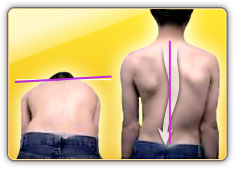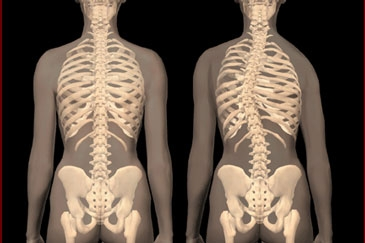Adam's forward bend test
Original Editor Heleen Van Cleynenbreugel
Top Contributors - Heleen Van Cleynenbreugel, Lydia Xenou, Stella Constantinides, Kim Jackson, George Prudden, Aminat Abolade, Admin, Magdalena Hytros, WikiSysop, Vidya Acharya, Claire Knott and 127.0.0.1
Definition/ Description[edit | edit source]
The patient takes off his/her t-shirt so that the spine is visible. The patient needs to bend forward, starting at the waist until the back comes in the horizontal plane, with the feet together, arms hanging and the knees in extension. The palms are hold together. The examiner stands at the back of the patient and looks along the horizontal plane of the spine, searching for abnormalities of the spinal curve, like increased or decreased lordosis/ kyphosis, and an asymmetry of the trunk.[1] [2] [3] [4]
Clinically Relevant Anatomy[edit | edit source]
The spine consists of 7 vertebrae cervicales, 12 vertebrae thoracicae, 5 vertebrae lumbales and an os sacrum composed of 5 vertebrae sacrales. For more information, see scoliosis on Physiopedia. When you look at the vertebral column in the sagittal plane, you see a cervical lordosis, thoracic kyfosis, lumbar lordosis and sacral kyfosis. [5]D Normally, the processus spinosi form a straight line. In patients with scoliosis, you see a lateral deviation in the frontal plane and a vertebral rotation, which can develop into a rib hump. [6], [7], [8]When the scoliosis progresses, the prossesus spinosi will rotate to the concave side of the column vertebrae. The costae are close together at the concavity of the curve and more separated at the convex side. The ribs follow the rotation of the corpus vertebrae and thus those of the processus spinosi. The rib hump develops because the posterior ribs on the convex side are being pushed to posterior and the anterior ribs on the concave side are pushed anteriorly. [8] [9]
Purpose[edit | edit source]
The purpose of the Adam’s forward bend test is detecting structural or functional scoliosis. This test is most often used during school screening for scoliosis. [2] [3] It can also be used with patients who have a family history of scoliotic posture or with patients who have detectable scoliosis of uncertain etiology. The scoliosis is functional when the characteristics of scoliosis becomes more visible while the patient bends. With a structural scoliosis, the scoliotic deformity will remain the same as in the standing position. [11]If there is an increased kyphosis when bending forward, Scheuermann’s disease or congential kyphosis is also possible. [12] [13]
Technique[edit | edit source]
Before you perform the Adam’s forward bend test, it is best to look for limb length discrepancy. The spine needs to be visible. The patient bends forward at the waist until the back comes in the horizontal plane, with feet together, arms hanging and knees extended. The palms are held together. The examiner looks from behind, along the horizontal plane of the column vertebrae. The examiner looks for indicators of scoliosis, such as spinal asymmetry, unlevel shoulders, scapula asymmetry, unlevel hips, the head that does not line up with the pelvis or a rib hump. An increased or decreased lordosis/kyphosis can also be a sign for scoliosis. [14], [15] The rotation deformity or rib hump can be measured with a scoliometer. [4] [12] [13] [16] [17]
Key Research[edit | edit source]
Radiography is the primary diagnostic procedure for scoliosis. Other diagnostic tools are a magnetic resonance imaging (MRI) or a computed tomography scan (CT-scan). [18] [19] Those are invasive methods to diagnose scoliosis. The search for a noninvasive, valid and reliable test is required so that the referrals for radiography can be reduced.[20] [21]A meta-analysis and a 10-year follow up evaluation about the effectiveness of school screening for scoliosis comes with the conclusion that the Adam’s forward bend test has a sensitivity of 84.3%, which suggests that the Adam’s forward bend test is a relatively powerful test when it is positive. The test has a specificity of 93.44%. These numbers are for a cobb angle > 10°. The studies still conclude that the test has too much false-negative findings to be a safe diagnostic criterion for an early detection of scoliosis. [22] [23] [24] [25] The Adam’s forward bend test in patients with a scoliosis of 40°, has a sensitivity of 0.83 and a specificity of 0.99. When looking at the thoracic and lumbar curves, we found a sensitivity of respectively 92% and 73%. The specificity is 60% and 68%. [24] [26] The interexaminer agreement is moderate in the thoracic spine (0, 61) and poor in the lumbar spine. [21] [23]The Adam’s forward bend test in school screening for scoliosis is also insufficient when done alone. [22] [23] [24] [25]
Clinical Bottom Line[edit | edit source]
The Adam’s forward bend test is a screening test for scoliosis. The test is most powerful for thoracic scoliosis. It is best combined with other test for scoliosis, like the scoliometer.
References[edit | edit source]
- ↑ 1.0 1.1 iScoliosis. Symptoms. http://www.iscoliosis.com/symptoms.html (accessed 11 November 2011)
- ↑ 2.0 2.1 Scoliosis. In Depth Revieuw of Scoliosis: Introduction, Clinical. http://www.e-radiography.net/radpath/s/scoliosis/scoliosis.htm (accessed 11 November 2011)
- ↑ 3.0 3.1 Scoliosis. Physical Examination. http://adam.about.net/reports/000068_5.htm (accessed 11 November 2011)
- ↑ 4.0 4.1 B.V. Reamy, J. B . Slakey. Adolescent idiopathic scoliosis: Review and current concepts. Am Fam Physician 2001; 1;64(1):111-117. Full version: http://www.aafp.org/afp/2001/0701/p111.html (accessed 11 November 2011) Level of evidence: A1
- ↑ M. Schünke, E. Shulte, U. Schumacher, M. Voll, K. Wesker. Prometheus: Algemene anatomie en bewegingsapparaat. Benige wervelkolom. Houten, 2008. P78-79. Level of evidence: D
- ↑ Orthopedie Amphia. Scoliose. http://www.orthopedie-amphia.nl/paginas/123-scoliose.html (accessed 11 November 2011)
- ↑ Harms Spinesurgery. Deformities; Definition, epidemiology, symptoms: Scoliosis. http://harms-spinesurgery.com/src/plugin.php?m=harms.SKO02E (accessed 12 November 2011)
- ↑ 8.0 8.1 8.2 Department of Radiology. Musculoskeletal Radiology: Scoliosis. http://www.rad.washington.edu/academics/academic-sections/msk/teaching-materials/online-musculoskeletal-radiology-book/scoliosis (accessed 12 November 2011)
- ↑ North Jersey Brain & Spine Center. Spinal Disorders: Scoliosis and Spinal Deformity. http://www.northjerseybrainspine.com/services/sd_ScoSpinDef.php (accessed 12 November2011)
- ↑ Plus online. Een scoliose, wat is dat? http://gezondheid.plusonline.nl/alles-over-rugpijn/artikelen/2170/een-scoliose-wat-is-dat- (accessed 11 November)
- ↑ K. Buckup. Clinical Tests for the Musculoskeletal System: Examinations- Signs- Phenomena. Adams Forward Bend Test. Stuttgart, Germany. 2005. Level of evidence: D
- ↑ 12.0 12.1 A. Clarke, A. Jones, M. O’Malley. ABC of Spinal Disorders. Examination. Oxford, 2010. P12 . Level of evidence: D
- ↑ 13.0 13.1 D.L. Skaggs, J.M. Flynn. Staying out of trouble in pediatric orthopaedics. Examination of the spine. Philadelphia, 2006. P20-21. Level of evidence: D
- ↑ Scoliosis 3DC- Schroth Method Exercise. Is it Scoliosis? http://scoliosis3dc.com/scoliosis-information/is-it-scoliosis/ (accessed 17 November 2011)
- ↑ Scoliosis Research Society. What Are the Signs of Scoliosis? http://www.srs.org/patient_and_family/patient_handbook/what_are_the_signs_of_scoliosis.htm (accessed 17 November 2011)
- ↑ M. Dutton. Orthopeadics for the Physical Therapist Assistant. Chapter 22. Ontario. P616. Level of evidence: D
- ↑ J. B. Emans, D. Hedequist, R. Miller et al. Reference Manual for the Boston Scoliosis Brace. 2003. P23 http://www.srs.org/professionals/education_materials/SRS_bracing_manual/section5.pdf (accessed 19 November) Level of evidence: D
- ↑ Lucile Packard Children’s Hospital at Stanford. Scoliosis. http://www.lpch.org/DiseaseHealthInfo/HealthLibrary/orthopaedics/scolio.html (accessed 16 November)
- ↑ Physiopedia. Scoliosis. http://www.physio-pedia.com/index.php5?title=Scoliosis (accessed 25 November 2011)
- ↑ KD Luk, CF Lee, KM Cheung et al. Clinical effectiveness of school screening for adolescent idiopathic scoliosis: a large population-based retrospective cohort study. Spine 2010; 1;15(17):1607-14 http://www.ncbi.nlm.nih.gov/pubmed/20453727 (accessed: 19 November) Level of evidence: C
- ↑ 21.0 21.1 P. Côté, B. Kreitz, JD Cassidy, AK Dzus, J. Martel. A study of the diagnostic accuracy and reliability of the scoliometer and Adam’s forward bend test. Spine 1998; 1;23(7):796-802 http://journals.lww.com/spinejournal/Abstract/1998/04010/A__Study_of_the_Diagnostic_Accuracy_and.11.aspx (accessed 12 November 2011) Level of evidence: A2
- ↑ 22.0 22.1 T Karachalios, J Sofianos, N Roidis, G Sapkas, D Korres, K Nikolopoulos. Ten-year follow-up evaluation of a school screening program for scoliosis. Is the forward-bending test an accurate diagnostic criterion for the screening of scoliosis? Spine 1999; 24(22):2318-24 http://www.ncbi.nlm.nih.gov/pubmed/10586455 (accessed 12 November) Level of evidence: A2
- ↑ 23.0 23.1 23.2 A M Virginia, EJ Elliott. The hands-on guide to imaging. Evidence based pediatrics and child health. London, 2004. p175-177. Level of evidence: B
- ↑ 24.0 24.1 24.2 R. Simpson, H. Gemmel. Accuracy of spinal orthopaedic tests: a systematic review. Chiropr Osteopat 2006; 10.1186/1746-1340-14-26 http://www.ncbi.nlm.nih.gov/pmc/articles/PMC1635718/?tool=pubmed (accessed 26 November 2011) Level of evicende: A1
- ↑ 25.0 25.1 DY Fong, CF Lee, KM Cheung et al. A meta-analysis of the clinical effectiveness of school scoliosis screening. Spine 2010; 35(10):1061-71 http://www.ncbi.nlm.nih.gov/pubmed/20393399 (accessed 25 November 2011) Level of evidence: A1
- ↑ CJ Goldberg, FE Dowling, EE Fogarty, DP Moore. School scoliosis screening and the United States Preventive Services Task Force. An examination of long-term results. Spine 1995; 20(12):1368-74 http://www.ncbi.nlm.nih.gov/pubmed/7676334 (accessed 26 November 2011) Level of evidence: A2








